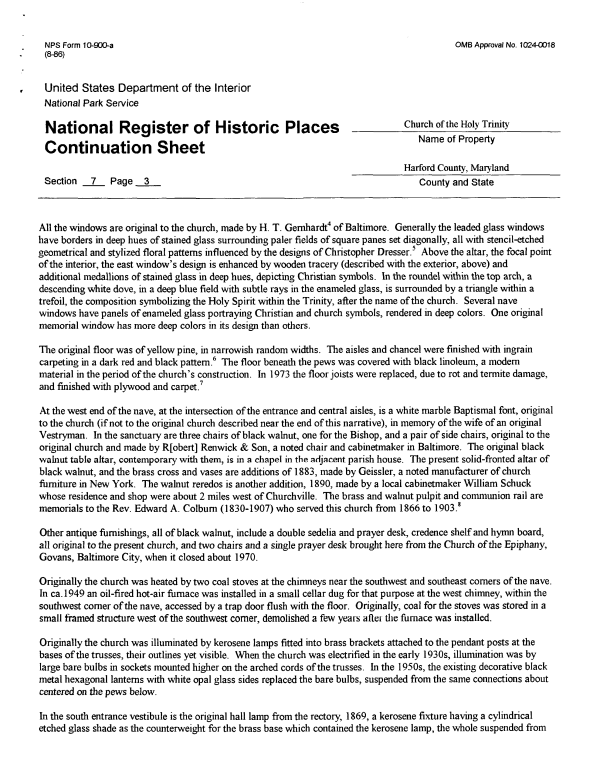 |
||||
|
DEPARTMENT OF HOUSING AND COMMUNITY DEVELOPMENT, MARYLAND HISTORICAL TRUST (Historic Sites Survey) var.d. MSA SE16-8 Image No: se16-8-0350 Enlarge and print image (88K) |
 |
||||
|
DEPARTMENT OF HOUSING AND COMMUNITY DEVELOPMENT, MARYLAND HISTORICAL TRUST (Historic Sites Survey) var.d. MSA SE16-8 Image No: se16-8-0350 Enlarge and print image (88K) |
| NPS Form 10-900-a OMB Approval No. 1024-0018 (8-86) United States Department of the Interior National Park Service Church of the Holy Trinity National Register of Historic Places __ -x .. .. r>l . Name of Property Continuation Sheet Harford County, Maryland Section 7 Page 3 County and State All the windows are original to the church, made by H. T. Gemhardt4 of Baltimore. Generally the leaded glass windows have borders in deep hues of stained glass surrounding paler fields of square panes set diagonally, all with stencil-etched geometrical and stylized floral patterns influenced by the designs of Christopher Dresser.5 Above the altar, the focal point of the interior, the east window's design is enhanced by wooden tracery (described with the exterior, above) and additional medallions of stained glass in deep hues, depicting Christian symbols. In the roundel within the top arch, a descending white dove, in a deep blue field with subtle rays in the enameled glass, is surrounded by a triangle within a trefoil, the composition symbolizing the Holy Spirit within the Trinity, after the name of the church. Several nave windows have panels of enameled glass portraying Christian and church symbols, rendered in deep colors. One original memorial window has more deep colors in its design than others. The original floor was of yellow pine, in narrowish random widths. The aisles and chancel were finished with ingrain carpeting in a dark red and black pattern.6 The floor beneath the pews was covered with black linoleum, a modem material in the period of the church's construction. In 1973 the floor joists were replaced, due to rot and termite damage, and finished with plywood and carpet.7 At the west end of the nave, at the intersection of the entrance and central aisles, is a white marble Baptismal font, original to the church (if not to the original church described near the end of this narrative), in memory of the wife of an original Vestryman. In the sanctuary are three chairs of black walnut, one for the Bishop, and a pair of side chairs, original to the original church and made by R[obert] Renwick & Son, a noted chair and cabinetmaker in Baltimore. The original black walnut table altar, contemporary with them, is in a chapel in the adjacent parish house. The present solid-fronted altar of black walnut, and the brass cross and vases are additions of 1883, made by Geissler, a noted manufacturer of church furniture in New York. The walnut reredos is another addition, 1890, made by a local cabinetmaker William Schuck whose residence and shop were about 2 miles west of Churchville. The brass and walnut pulpit and communion rail are memorials to the Rev. Edward A. Colburn (1830-1907) who served this church from 1866 to 1903.8 Other antique furnishings, all of black walnut, include a double sedelia and prayer desk, credence shelf and hymn board, all original to the present church, and two chairs and a single prayer desk brought here from the Church of the Epiphany, Govans, Baltimore City, when it closed about 1970. Originally the church was heated by two coal stoves at the chimneys near the southwest and southeast comers of the nave. In ca.1949 an oil-fired hot-air furnace was installed in a small cellar dug for that purpose at the west chimney, within the southwest corner of the nave, accessed by a trap door flush with the floor. Originally, coal for the stoves was stored in a small framed structure west of the southwest corner, demolished a few years after the furnace was installed. Originally the church was illuminated by kerosene lamps fitted into brass brackets attached to the pendant posts at the bases of the trusses, their outlines yet visible. When the church was electrified in the early 1930s, illumination was by large bare bulbs in sockets mounted higher on the arched cords of the trusses. In the 1950s, the existing decorative black metal hexagonal lanterns with white opal glass sides replaced the bare bulbs, suspended from the same connections about centered on the pews below. In the south entrance vestibule is the original hall lamp from the rectory, 1869, a kerosene fixture having a cylindrical etched glass shade as the counterweight for the brass base which contained the kerosene lamp, the whole suspended from |